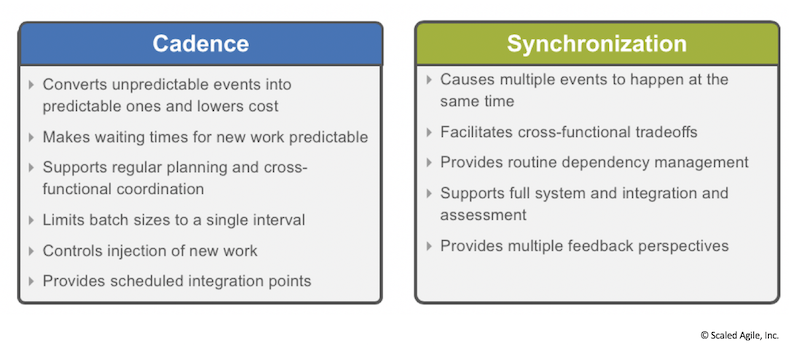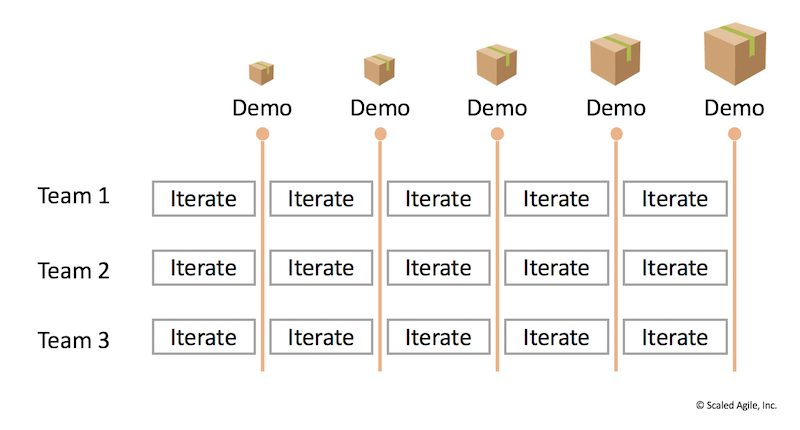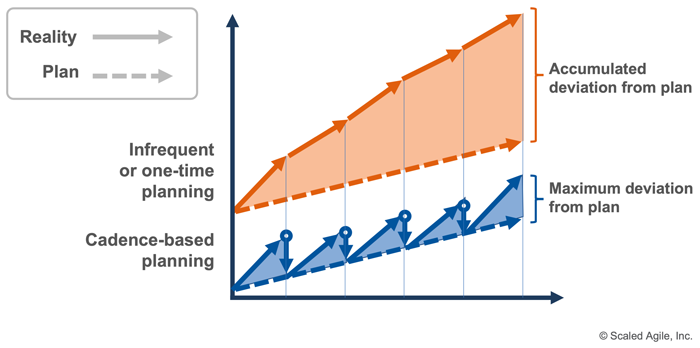Cadence and synchronization limit the accumulation of variance.
—Don Reinertsen, Principles of Product Development Flow
Principle #7 – Apply cadence, synchronize with cross-domain planning
Solution development is an inherently uncertain process. If it weren’t, the solutions would already exist, and there would be no room for the next generation of innovations. This uncertainty conflicts with the need for businesses to manage investments, track progress, and have sufficient confidence in future outcomes to plan and commit to a reasonable course of action.
To address this, Agile development functions best in a ‘safety zone’, where enough uncertainty provides the freedom to pursue innovation and react to events, while also providing confidence the business needs to operate. The primary means to achieve this balance is through the objective knowledge of the current state. It’s just easier when you know where you really are. This knowledge is gained by applying cadence, synchronization, and periodic cross-domain planning.
Cadence is a rhythmic pattern of events that provides the steady heartbeat of the development process. It makes routine everything that can be routine, so developers can focus on managing the variable part of solution development. Synchronization allows multiple solution perspectives to be understood, resolved, and integrated at the same time.
The benefits of cadence and synchronization are highlighted in Figure 1 below.

Taken together, cadence and synchronization help Agile teams proceed confidently despite the inherent uncertainty.
Cadence and synchronization enable flow
Thanks to Don Reinertsen’s principles of product development flow [1] we can explain why cadence and synchronization are critical to effective solution development. Some of these principles are summarized in Tables 1 and 2 below, along with the relevant SAFe practices that implement them.
| Principles of Flow: Cadence | SAFe Practices |
| F5: Use a regular cadence to limit the accumulation of variance | Planning at regular PI intervals limits variances to a single PI timebox, increasing Agile Release Train (ART) and Solution Train predictability. |
| F6: Provide sufficient capacity margin to enable cadence | In order to reliably meet PI objectives, the Innovation and Planning (IP) iteration has no planned scope and provides a schedule margin (buffer). In addition, planned-for but uncommitted objectives provide capacity margin (scope buffer). Together, they offer a way to reliably meet PI goals. |
| F7: Use cadence to make waiting times predictable | If a Feature doesn’t make it into a PI but remains a high priority, its delivery can be scheduled for the next PI (or another scheduled, frequent release). This avoids the temptation to load excess Work in Process (WIP) into the current increment. |
| F8: Use a regular cadence to enable small batch sizes | Short iterations help control the number of Stories in the iteration batch. Feature batch sizes are controlled by short PIs and frequent releases, providing high system predictability and throughput. |
| F9: Schedule frequent events using a predictable cadence | PI planning, System Demos, Inspect and Adapt (I&A), ART Sync, Iteration Planning, backlog refinement, and architecture discussions are examples of things that benefit from frequent events. Each event needs to process only a small batch of new information. Cadence helps lower the transaction costs of these events. |
Table 1: Cadence principles applied in SAFe
| Principles of Flow: Synchronization | SAFe Practices |
| F10: Exploit economies of scale by synchronizing work from multiple projects | Individual Agile Teams are aligned to common iteration lengths. Work is synchronized by system and solution demos. Portfolio business and Enabler Epics drive common infrastructure and Customer utility. |
| F11: Capacity margin enables synchronization of deliverables | The Innovation and Planning (IP) iteration enables the final PI system demo, and solution demo to occur without taking velocity away from ARTs or Solution Trains. |
| F12: Use synchronized events to facilitate cross-functional trade-offs | ART and Solution Train events synchronize customer feedback and enable resource and budget adjustments, mission alignment, continuous improvement, and program oversight and governance. They also drive collaboration and team building. |
| F13: To reduce queues, synchronize the batch size and timing of adjacent processes | Teams are aligned to common timeboxes and similar batch sizes. The ART and solution system teams support integration on a regular cadence. To facilitate the rapid delivery of new ideas, backlogs are kept short and uncommitted. |
| F14: Apply nested cadence harmonic multiples to synchronize work | Teams integrate and evaluate on iteration boundaries (at least). ARTs and Solution Trains evaluate on PI boundaries. |
Table 2: Synchronization principles applied in SAFe
Taken together, cadence and synchronization are critical concepts that help us manage the inherent variability of our work. This creates a more reliable, dependable solution development and delivery process, one that our key business stakeholders can come to rely on.
Aligning Development Cadence
Agile teams naturally apply cadence via short iterations (or Sprint) cycles. However, even when working together, these cadence-based cycles may not lend themselves to effective synchronization, as Figure 2 illustrates.

As Figure 2 illustrates, each team is “sprinting” on a cadence, but the cadences are different, and the system itself may or may not be evolving as planned. Operating on a common cadence—and adding the synchronization of routine system demos—addresses this concern, as illustrated in Figure 3

In Figure 3, the system is now truly ‘sprinting’, as is illustrated by the objective evidence from the regular system demo.
Synchronize with Cross-Domain Planning
In addition to common cadence, periodic cross-domain planning (example: PI Planning in SAFe) provides the opportunity for the various aspects of a solution—business and technical —to be integrated and evaluated together at one time. This has the net effect of managing variability by frequently revisiting and updating the plan. In other words, cadence-based planning limits variability to a single interval, as Figure 4 illustrates.

In this way, the ‘plan is far closer to the reality’. Business conditions are significantly improved when everyone is operating in accordance with a current and realistic plan, which is tuned and adjusted as new facts emerge.
Summary
There’s no cure for the inherent uncertainty of solution development. If there were, it would surely be worse than the disease. However, applying cadence and synchronization, along with periodic cross-domain planning, provides the tools needed to operate in the safety zone.
Learn More
[1] Reinertsen, Donald. The Principles of Product Development Flow: Second Generation Lean Product Development. Celeritas Publishing, 2009. [2] Kennedy, Michael. Product Development for the Lean Enterprise. Oaklea Press, 2003.Last update: 10 February 2021





